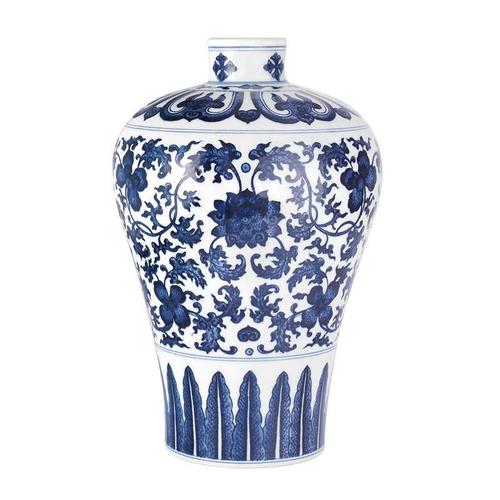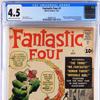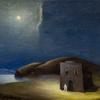Collectors' Guide: Asian Art Week New York
- September 08, 2010 12:42

From Edo Castle folding screens to Indian miniature paintings, snuff bottles to jade carvings, a vast array of Asian art and antiques is on the market this month in New York City.
Each Spring and Fall, museum curators, private collectors, dealers, and art enthusiasts descend upon the city for a dynamic range of gallery exhibitions and auctions as well as museum shows.
Last March, four days of Asian art sales at Christie's alone garnered nearly $60 million, including Yu Zhiding's Happiness through Chan Practice: Portrait of Wang Shizhen, a handscroll in ink and color on silk, which sold for $3,442,500, a US auction record price for a Chinese classical painting.
This September promises to yield up more treasures. Among the highlights is a selling exhibition centered wholly on white marble carvings, also known as Chinese white jade, at M.D. Flacks, and a monumental pair of screens by Ishizaki Koyo, titled "Vying Peacocks," as well as a cache of recently discovered Taisho Period screens and scrolls, debuting at Erik Thomsen's new gallery.

Fall Asian Art Week events and exhibitions include:
CHINESE ART, ANCIENT THROUGH CONTEMPORARY
At the Ralph M. Chait Galleries, 724 Fifth Avenue, An Autumn Feast of Color: Fine Chinese Ceramics and Works of Art will showcase an array of polychrome decorated porcelains and works of art of superb quality from a private collection. One of the highlights is a very rare pair of 18th century painted ivory, jade and hardstone appliqué figures of a court lady and gentleman. www.rmchait.com
Literati Musing: Inscriptions on Chinese Paintings and Scholar Objects, will be held at China 2000 Fine Art, 434A East 75th Street. Like the contemporary Twitter, ancient inscriptions on Chinese art were the momentary (and now art historically monumental) thoughts about society, relationships, politics, and aesthetics of the literati. Karen and Leon Wender gathered together objects for the scholar’s desk and Chinese paintings that bear inscriptions by eminent scholars and calligraphers of Chinese history. The scholar’s words, literally etched in stone or wood or written with indelible ink on paper, provide clues to where they were at particular times in their lives and offer their knowledge about the object or the painting upon which they inscribe their thoughts. Among the exhibition’s highlights is an Important Scholar Rock Anhui Inkstone with calligraphy by Ding Jing, dated 1750 and a Ming dynasty poem carved onto on a soapstone seal-paste box by Deng Shiru, a very important calligrapher and seal carver from the 18th century. www.China2000Fineart.com

Kaikodo, 74 East 79th Street, presents Buddhist Lives, which includes Chinese and Japanese paintings from the 14th century to contemporary works featuring images of the Buddha along with stone and gilt bronze Buddhist sculpture. The paintings cover a wide range of styles and subjects, from an early image of Sakyamuni attributed to the Yuan-dynasty painter Yan Hui, to several paintings of lohan dating to the Ming and Qing dynasties to a “Bodhidharma Meditating” by Zhang Daqian painted in the 1930’s. The most recent works include stamped images of the Buddha by Mansheng Wang, who had a successful exhibition at the Today Museum in Beijing this summer, and a photograph by Michael Cherney of a bodhisattva from a Tang-period Buddhist cave printed on xuan paper and mounted as a hanging scroll. Japanese paintings featured in the exhibition include a large and impressive “Neihanzu” (death of the Buddha), Sesshin’s “Daruma,” Isshi’s “Kannon,” and Kano Tanyu’s “Jizo.” www.kaikodo.com
Marble at M D Flacks, Ltd. 32 East 57th Street, will feature small marble treasures including: A Leaf-shaped Tray, circa 17th-early 18th century; a rare 18th century white marble vase, and a rare Censor (17th-early 18th century) that is identical in shape to ceramic and bronze examples from the Ming and early Qing dynasties. According to Marcus Flacks, this is the first time that an exhibition solely concentrated on White Marble, sometimes referred to as Chinese White Jade, has been mounted. “There was a rich tradition of skilled masonry in China and the quality and variety included in this unique show affords us a look into that culture,” Flacks said. www.mdflacks.com
INDIAN, HIMALAYAN, AND SOUTHEAST ASIAN WORKS OF ART
Art of the Past, 1242 Madison Avenue, presents Rasananda – A Celebration of Aesthetic Bliss. The items selected for this exhibition explore the perceptions of beauty in the history of South and Southeast Asian art. Highlights are: a Ramayana painting from Kangra, circa 1820, Rama, Sita, and Lakshmana Visiting the Hermitage of Bharadwaja. Among the other works included in the exhibition are a colossal stucco head of a Bodhisattva from the Gandhara Region, and an important bronze Chola Period sculpture of Parvati. www.artofpast.com
Following the success of previous co-exhibitions, the Asian Art galleries at 311 East 72nd Street, which include Arnold Lieberman, Leiko Coyle Asian Art and Theresa McCullough, join forces once again for September Asia Week.
Leiko Coyle features Recent Acquisitions, a selection of Tibetan Thangkas ranging from the 14th to the 19th centuries. Complimenting these works on fabric will be an array of sculpture from Tibet, Nepal and India, including a large stone relief of Ganesh, the Hindu God of prosperity and good fortune. www.lcasianart.com
Arnold Lieberman presents a special display of exceptional recent acquisitions. Included are a large (and fierce) 17th- - 18th century Tibetan Thangka painting of Sri Devi, a bronze Gupta period water vessel in the form of Nandi, a rare stone Vaishnavite goddess from the Hoysala Era in India, and other distinctive objects primarily from South Asia and the Himalayan regions. www.arnoldlieberman.com
Theresa McCullough, rounds out the trio with her Recent Acquisitions, which includes a selection of Indian and Southeast Asian sculpture and Indian miniature paintings. The highlight is an exquisitely executed painting, titled Padam Singh Rathore and Consort Drinking Rose Water, Noor Muhammed (known as Nure), who ran the royal workshop of Bikaner from 1700-1715 and had previously been a leading artist in the workshops of Ruk-Nud-Din, Ibrahim and Nathu Ji. He was one of the master painters of the Bikaner school. Padam Singh Rathore was killed in battle in 1683 and the piece was painted in commemoration of him and would have been presented to the royal family as a token of respect. www.theresamccullough.com
Kapoor Galleries Inc., 1015 Madison Avenue, will present Recent Acquisitions featuring an important sculpture from Eastern India of a Dancing Ganesha, dated to the 12th century. Also on view will be a finely cast image of a Jain Tirthankara, from South India, and a very fine leaf from a Ramayana series, from Mandi, dating to circa 1700. www.kapoorgalleries.com
Indian and Southeast Asian Master Works of Art, at Doris Wiener, 1001 Fifth Avenue, will include a Dancing Ganesh in black stone (Pala Period, 9th-10th century) from Northeastern India or Bengal, Chola bronzes, a rare pre-Khmer Krishna Govinda, a selection of Himalayan gilt bronzes and Thangkas, a sumptuous Pala Buddha, and recently acquired Khmer and Indian sculptures. Dorisweinergallery@gmail.com
In Flora, Fauna, and Sacred Geometry; A Timeless Presence, Nancy Wiener, Inc., at The Ansonia on2109 Broadway, reveals that life and form from the simple to the intricate are an integral part of sacred Indian and Southeast Asian art, finding their ways from great public edifices into the private settings of devotion and adornment. One example Wiener will showcase is an arresting Pre-Angkorian Ganesha, which merges the human and the animal into a single pristine form.
nancywienergallery@mac.com
JAPANESE AND KOREAN, ANCIENT TO CONTEMPORARY ART
Joan B. Mirviss Ltd., 39 East 78th Street, presents Flights of Fancy, masterworks in enameled porcelain by Kutani master Takegoshi Jun. Forty new works will be featured, including several larger scale forms, created exclusively for this show, his second one in the United States. Using his signature jewel-like glazes to depict various species of birds, Takegoshi’s carefully painted, sometimes whimsical compositions are always in harmony with his uniquely shaped hand-built vessels. His use of polychrome over-glaze enamels on opaque and visually flat white porcelain adds to the push and pull between surface and space. www.mirviss.com
Scholten Japanese Art, 145 West 58th Street, marks their tenth year in New York with a special presentation, 2010: 20th Century Japanese Prints and Paintings, 10th Anniversary. This exhibition reflects the gallery’s continuing interest in the intertwining development of Japanese woodblock prints from the early to mid-20th century by artists who designed shin-hanga (lit. ‘new prints’) and sosaku-hanga (lit. ‘creative prints’). The show will include twenty to thirty woodblock prints and a few original paintings, by popular masters such as Hashiguchi Goyo, Kaburagi Kiyokata, Ito Shinsui, Kobayakawa Kiyoshi (1896-1948), Kitano Tsunetomi, Takahashi Hiroaki, Kawase Hasui, and Torii Kotondo. Scholten will also exhibit a select few examples of color woodblock prints by Western artists who played a role in the development of these genres, including Arthur Wesley Dow, Emil Orlik. Bertha Lum, and Fritz Capelari. www.scholten-japanese.com
On view at Kang Collection Korean Art, 9 East 82nd Street, are two concurrent art exhibitions, which will illustrate the different realms of men and women during the late Joseon Dynasty: Revelations of the Brush: Joseon Scholar Ink Paintings, exhibited in the main gallery, showcases classic monochromatic screens and hanging scrolls by Joseon scholar officials. The traditional subjects, include the Four Gentlemen (plum, orchid, chrysanthemum and pine), landscapes, and calligraphy, are depicted by different artists, revealing individual varieties of expression and character. Hidden Beauty: Lacquerware, Garments, and Furniture from the Joseon Women’s Quarters, highlights furnishings that would have adorned the inner quarters of Joseon women, including fine lacquer cosmetic boxes, mirrors and tables; metal-fitted wooden chests; decorative screens; and traditional silk garments.
www.kangcollection.com
Japanese Art Dealers Association
Kokon Biannual: Fall '10
September 13 - October 12, 2010
Mon. - Fri., 10:00 AM - 6:00 PM
Koichi Yanagi Oriental Fine Arts
17 E. 71st St., 4th Fl. • New York, NY 10021 • 212.744.5577
Koichi Yanagi Oriental Fine Arts' fall exhibition, Kokon Biannual: Fall '10, features works of art representing nearly all major eras of Japanese history, from the Heian through the late Edo period.
The Fall 2010 exhibition includes major paintings, a calligraphic work by a preeminent Zen prelate, majestic folding screens, and enchanting ceramics, one from the Heian and the other from the Edo period. A sumptuous pair of folding screens attributed to Kano Eitoku (1543-1590) and known to have been part of the furnishings of Edo Castle - the present-day Imperial Palace in Tokyo - was once in the possession of one of the Tokugawa shoguns. It depicts a ceremonious occasion during which a Chinese emperor receives tribute bearers from abroad, a truly fitting subject for screens in a shogunal collection. Kano Eitoku was a progenitor of the monumental Momoyama style, and the attribution was made and inscribed on the screens by Tan'yū (1602-1674), Eitoku's grandson, the most powerful artist of the Edo period.
A painting executed in a delicate, almost miniaturist style on a shikishi (a type of paper “card”, almost square in shape, that was often used for calligraphy), represents a scene from the Genji monogatari, Japan’s most celebrated classic. Although unattributed when acquired, Mr. Yanagi arranged to have the backing sheet removed from this painting, revealing the seal of the Tosa school master Mitsuyoshi (1539-1613).
Images of the Floating World: Paintings, Prints, and Illustrated Books
September 14 - 17 and 20 - 24, 2010
10:00 AM to 5:00 PM
Sebastian Izzard LLC Asian Art
17 East 76th St., 3rd Fl. • New York, NY 10021 • 212.794.1522
info@izzardasianart.com • www.izzardasianart.com
Sebastian Izzard LLC will feature a selection of paintings, woodblock prints, and illustrated books in their annual exhibition of fine ukiyo-e to be held during Asia Week in New York this September. The show will feature a range of images of beauties, actors, landscapes, and bird and flower subjects from the 18th and 19th centuries.
Paintings by Edo period masters such as Kaigetsudō Dohan, Tōsendō Rifu, Hosoda Eishi, and Utagawa Toyokuni will be exhibited and will include a rare painting by an amateur artist of the late 18th century, Aoki Masatada, depicting Hanaogi IV, dating from ca. 1794. A fine example of Utamaro's "The Silver World" (Gin Sekai), complete with original covers and title slip, will highlight the group of illustrated books. Among the prints is a very rare first edition of Hiroshige's color woodblock triptych "Night View of the Sumida River," depicting two geisha of the Azumaya (the name in hiragana on the maid's lantern) and their attendant strolling on the embankment at night beneath flowering cherry.
Kyozo: Images of the Unity of Shinto and Buddhism
September 10 - 30, 2010
Tues. - Sat., 11:00 AM - 5:00 PM
Art of Zen Monks
September 10 - October 30, 2010
Tues. - Sat., 11:00 AM - 5:00 PM
Mika Gallery
595 Madison Ave., 8th Fl. • New York, NY 10022 • 212.888.3900
info@mikagallery.com • www.mikagallery.com
Mika Gallery will be holding two exhibitions of pre-Modern Japanese art. Kyozo: Images of the Unity of Shinto and Buddhism is a form of art that has not been widely exhibited in the United States. Kyozo are drawings made on the surface of a mirror. The subjects of the drawings are a fusion of representations of the gods of the ancient religions of Japan (Shinto) and Buddhist deities who were introduced to Japan from overseas. The ancient art form is based on Honjisuijaku, a theory that provided for the conciliation of Shinto and Buddhist deities. The exhibition includes ten select works, mainly from the 12th century Heian period.
Art of Zen Monks presents works of art by the Zen painter Tozen Hosetsu and the Zen Master Hakuin. Works by Hosetsu, who is also well known as Sesshū Tōyō's disciple, will include paintings of landscapes and Dharma. Works by Hakuin will include calligraphies and paintings. Together with the paintings by the monks, a sculpture of Manjusri, in the form of a training monk (Kamakura period), which was originally sited in the meditation hall of a temple will be exhibited.
Screens and Scrolls of the Taisho Period
September 15 - November 19, 2010
Mon. - Fri. 12:00 PM to 5:00 PM and by appointment
Erik Thomsen Asian Art
23 E. 67th St. • New York, NY 10065 • 212.288.2588
info@erikthomsen.com • www.erikthomsen.com
Erik Thomsen Asian Art will launch its 25th Anniversary Year and inaugurate its new gallery with an exhibition of Taisho Period (1912-1926) art, Screens and Scrolls of the Taisho Period, an exhibition that presents more than a dozen newly discovered screens and scroll paintings.
Among the highlights of the exhibition is a monumental pair of screens by Ishizaki Koyo, Vying Peacocks, which measures 32 feet across.
While short in duration, the influential Taisho Period (1912-26) witnessed a flowering of the arts in Japan. It was a period of great wealth, especially for the Zaibatsu industrialists, and art was eagerly collected. Often over-sized exhibition pieces with a bold design, they are made using the finest materials and mountings. Unlike the preceding Meiji Period (1868-1912), during which art was made mostly for export to the West, art in the Taisho Period was made for the Japanese and rarely left Japan. This new trend continued in the following Showa Period (1926-89) until World War II. Since few Taisho and early Showa screens left Japan, little was known about them in the West until the acclaimed 2002 exhibition Taisho Chic at the Honolulu Academy of Arts. Screens and Scrolls of the Taisho Period will focus on more than a dozen-many newly discovered-screens and scrolls of the Taisho period.
Auction houses
Sotheby's
72nd Street and York Avenue
Sept. 14 - The Joe Grimberg Collection of Chinese Snuff Bottles
Sept. 9-13 - Public exhibition
Sept. 15 - Fine Chinese Ceramics & Works of Art
Sept. 9-14 - Public exhibition
Sept. 16 - South Asian Art
Sept. 9-15 - Public exhibition
Doyle New York
175 East 87th Street
Sept. 13 – Asian Works of Art
Sept. 10-12 – Public exhibition
Christie's
20 Rockefeller Plaza
Sept. 14 - Indian and Southeast Asian Art
Sept. 10-14 – Public exhibition
Sept. 15 - South Asian Modern & Contemporary Art
Sept. 10-14 – Public exhibition
Sept. 15 - Japanese & Korean Art Including Arts of the Meiji Period
Sept. 10-14 – Public exhibition
Sept. 16 - Sze Yuan Tang Archaic Bronzes from the Anthony Hardy Collection
Sept. 10-15 – Public exhibition
Sept. 16 - Fine Chinese Ceramics and Works of Art Including Property from the Arthur M. Sackler Collections
Sept. 10-15 – Public exhibition
Sept. 16-17 - Fine Chinese Ceramics and Works of Art
Sept. 10-15 – Public exhibition
Bonhams
580 Madison Avenue
Sept. 14 - Japanese Works of Art
Sept. 10-14 – Public exhibition




















